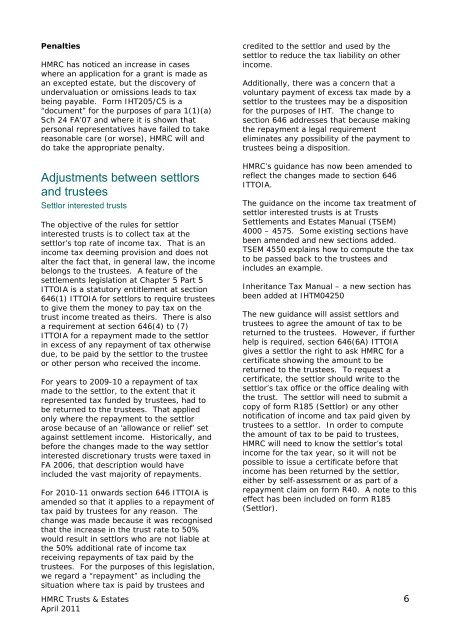HMRC Trusts & Estates newsletter - HM Revenue & Customs
HMRC Trusts & Estates newsletter - HM Revenue & Customs
HMRC Trusts & Estates newsletter - HM Revenue & Customs
Create successful ePaper yourself
Turn your PDF publications into a flip-book with our unique Google optimized e-Paper software.
Penalties<br />
<strong><strong>HM</strong>RC</strong> has noticed an increase in cases<br />
where an application for a grant is made as<br />
an excepted estate, but the discovery of<br />
undervaluation or omissions leads to tax<br />
being payable. Form IHT205/C5 is a<br />
“document” for the purposes of para 1(1)(a)<br />
Sch 24 FA’07 and where it is shown that<br />
personal representatives have failed to take<br />
reasonable care (or worse), <strong><strong>HM</strong>RC</strong> will and<br />
do take the appropriate penalty.<br />
Adjustments between settlors<br />
and trustees<br />
Settlor interested trusts<br />
The objective of the rules for settlor<br />
interested trusts is to collect tax at the<br />
settlor’s top rate of income tax. That is an<br />
income tax deeming provision and does not<br />
alter the fact that, in general law, the income<br />
belongs to the trustees. A feature of the<br />
settlements legislation at Chapter 5 Part 5<br />
ITTOIA is a statutory entitlement at section<br />
646(1) ITTOIA for settlors to require trustees<br />
to give them the money to pay tax on the<br />
trust income treated as theirs. There is also<br />
a requirement at section 646(4) to (7)<br />
ITTOIA for a repayment made to the settlor<br />
in excess of any repayment of tax otherwise<br />
due, to be paid by the settlor to the trustee<br />
or other person who received the income.<br />
For years to 2009-10 a repayment of tax<br />
made to the settlor, to the extent that it<br />
represented tax funded by trustees, had to<br />
be returned to the trustees. That applied<br />
only where the repayment to the settlor<br />
arose because of an ‘allowance or relief’ set<br />
against settlement income. Historically, and<br />
before the changes made to the way settlor<br />
interested discretionary trusts were taxed in<br />
FA 2006, that description would have<br />
included the vast majority of repayments.<br />
For 2010-11 onwards section 646 ITTOIA is<br />
amended so that it applies to a repayment of<br />
tax paid by trustees for any reason. The<br />
change was made because it was recognised<br />
that the increase in the trust rate to 50%<br />
would result in settlors who are not liable at<br />
the 50% additional rate of income tax<br />
receiving repayments of tax paid by the<br />
trustees. For the purposes of this legislation,<br />
we regard a “repayment” as including the<br />
situation where tax is paid by trustees and<br />
credited to the settlor and used by the<br />
settlor to reduce the tax liability on other<br />
income.<br />
Additionally, there was a concern that a<br />
voluntary payment of excess tax made by a<br />
settlor to the trustees may be a disposition<br />
for the purposes of IHT. The change to<br />
section 646 addresses that because making<br />
the repayment a legal requirement<br />
eliminates any possibility of the payment to<br />
trustees being a disposition.<br />
<strong><strong>HM</strong>RC</strong>’s guidance has now been amended to<br />
reflect the changes made to section 646<br />
ITTOIA.<br />
The guidance on the income tax treatment of<br />
settlor interested trusts is at <strong>Trusts</strong><br />
Settlements and <strong>Estates</strong> Manual (TSEM)<br />
4000 – 4575. Some existing sections have<br />
been amended and new sections added.<br />
TSEM 4550 explains how to compute the tax<br />
to be passed back to the trustees and<br />
includes an example.<br />
Inheritance Tax Manual – a new section has<br />
been added at IHTM04250<br />
The new guidance will assist settlors and<br />
trustees to agree the amount of tax to be<br />
returned to the trustees. However, if further<br />
help is required, section 646(6A) ITTOIA<br />
gives a settlor the right to ask <strong><strong>HM</strong>RC</strong> for a<br />
certificate showing the amount to be<br />
returned to the trustees. To request a<br />
certificate, the settlor should write to the<br />
settlor’s tax office or the office dealing with<br />
the trust. The settlor will need to submit a<br />
copy of form R185 (Settlor) or any other<br />
notification of income and tax paid given by<br />
trustees to a settlor. In order to compute<br />
the amount of tax to be paid to trustees,<br />
<strong><strong>HM</strong>RC</strong> will need to know the settlor’s total<br />
income for the tax year, so it will not be<br />
possible to issue a certificate before that<br />
income has been returned by the settlor,<br />
either by self-assessment or as part of a<br />
repayment claim on form R40. A note to this<br />
effect has been included on form R185<br />
(Settlor).<br />
<strong><strong>HM</strong>RC</strong> <strong>Trusts</strong> & <strong>Estates</strong> 6<br />
April 2011

















